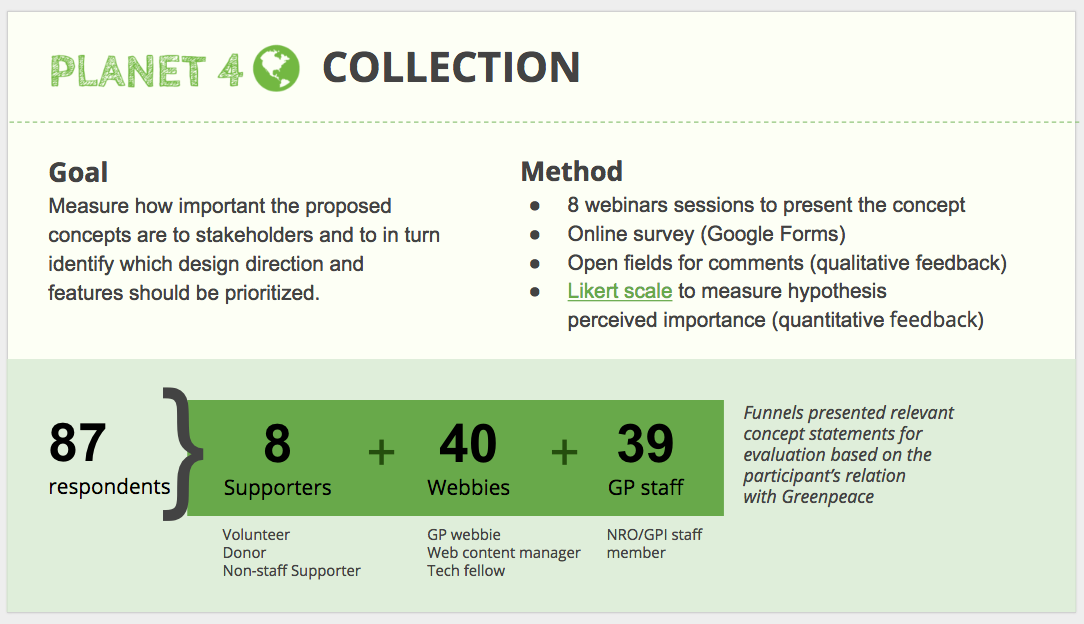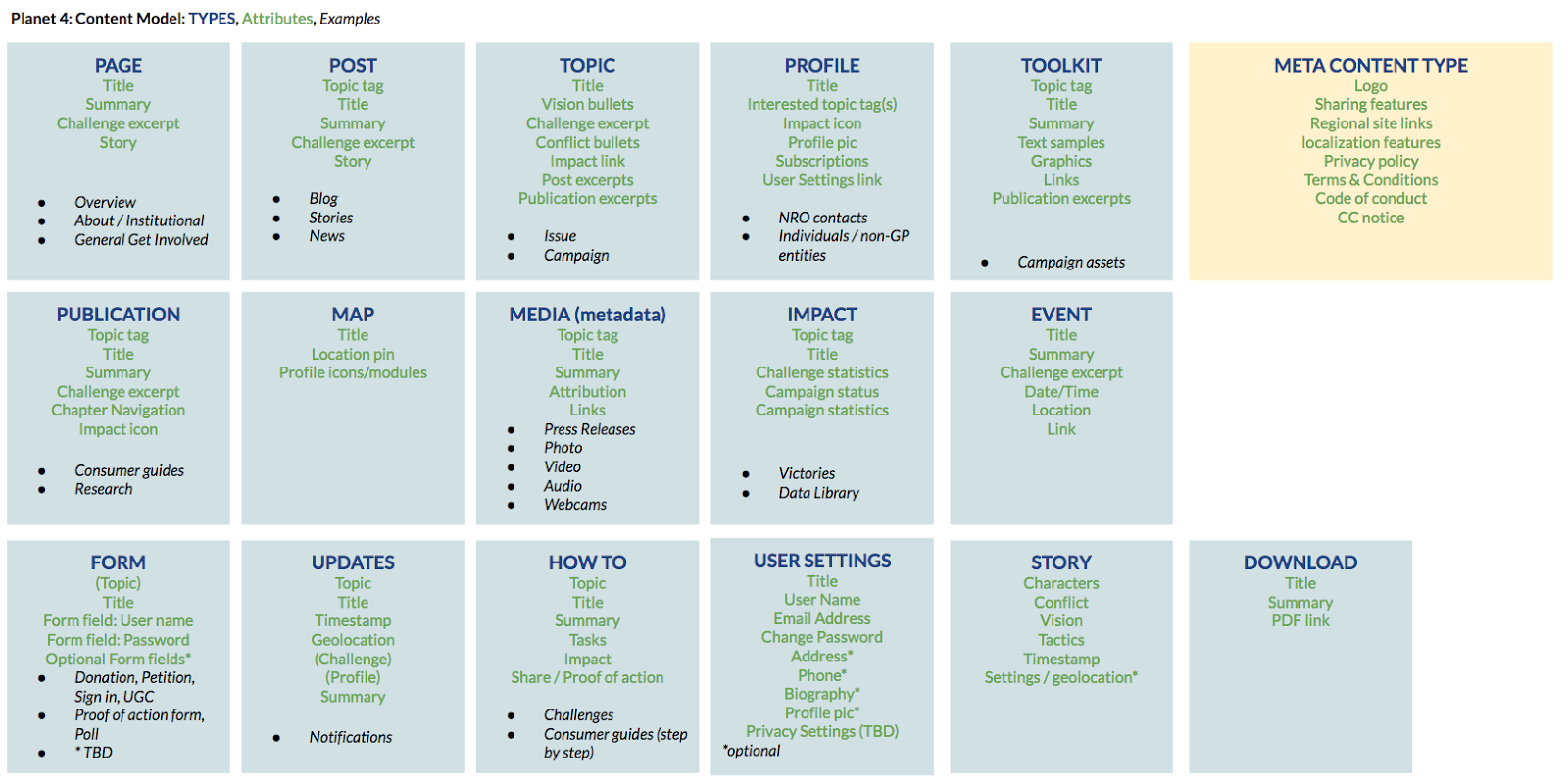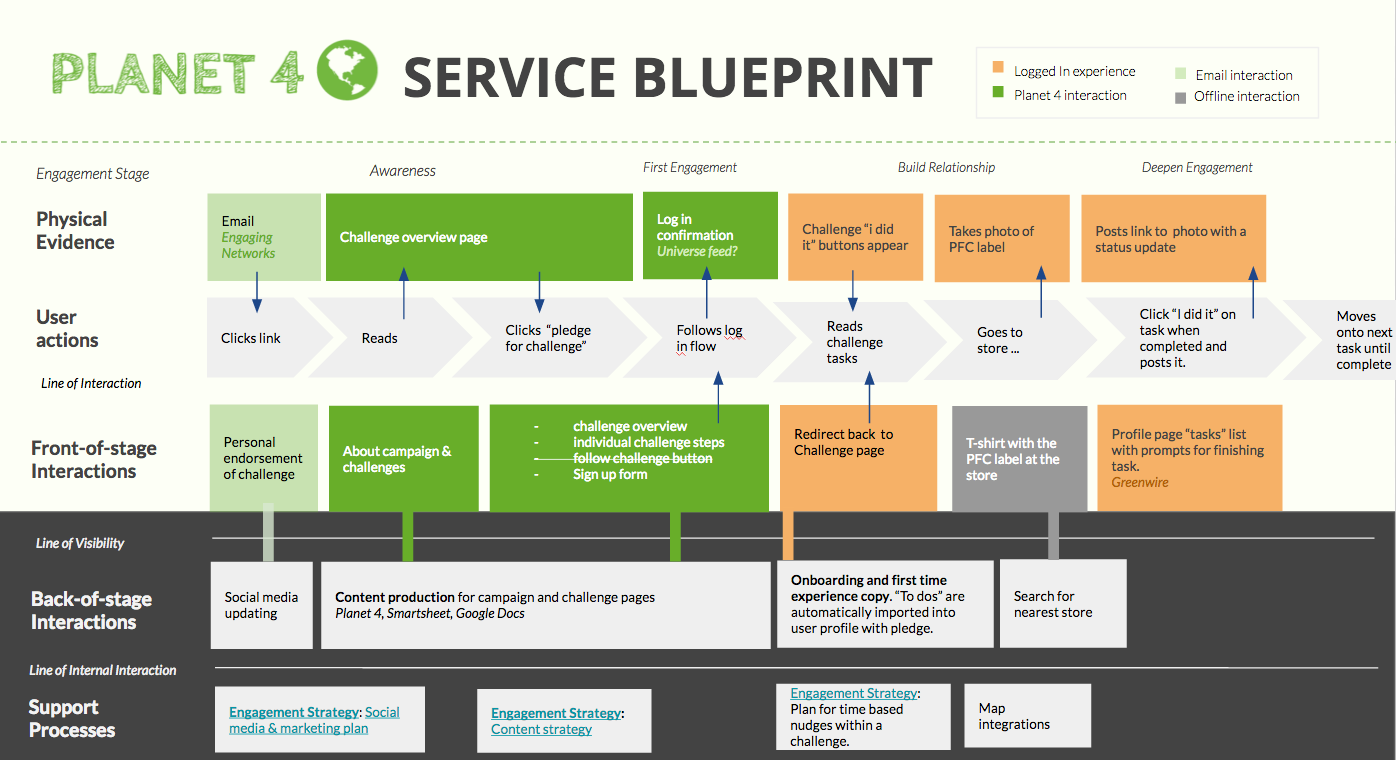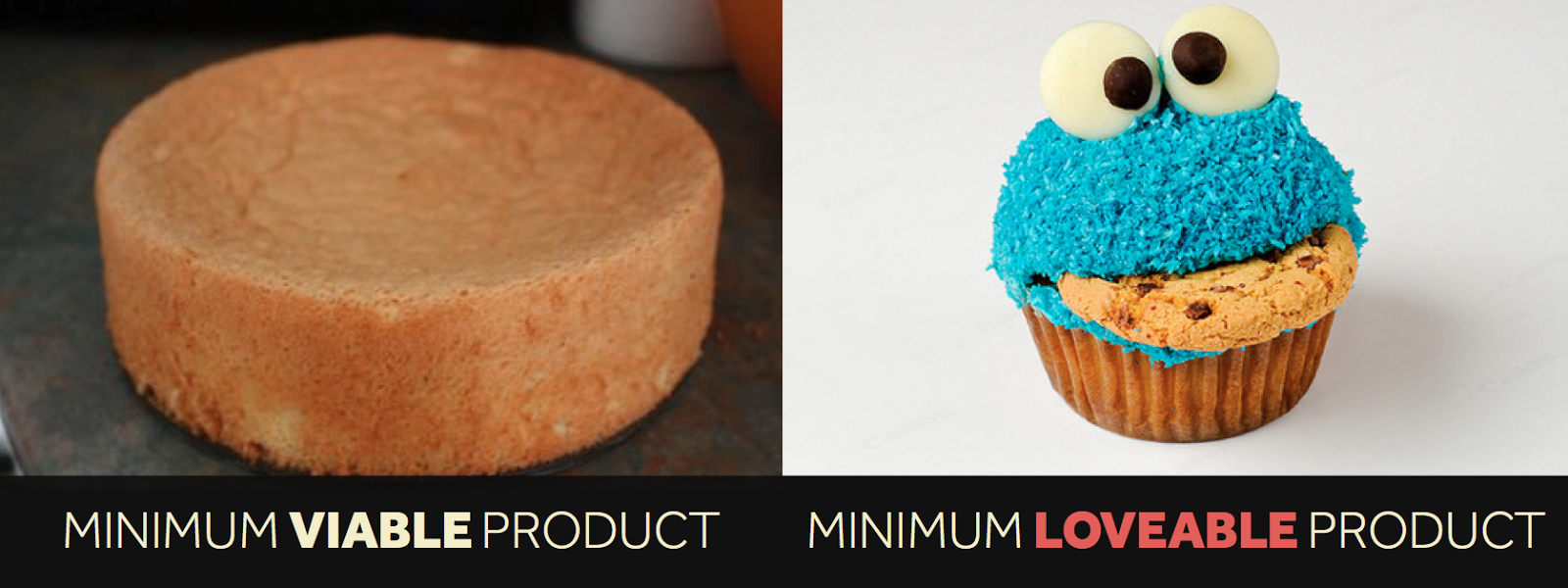Over the past month, the Planet 4 Design team focused on the refinement of the initial Concept, taking both qualitative and quantitative feedback to prioritize, contextualize and identify which design direction and features should be included in the first product release.
The result of this piece of work is the Refined Concept Deck, which, beside summarizing and processing the feedback received from the global community, de facto concludes the Concept phase and makes the project transition into Design.
From Design Principles to Concept Development: the methodology
The initial design work of the Concept Development phase mostly focused on research and ideation. Through synchronous and asynchronous iteration and brainstorming, the team developed a series of four design guiding principles to facilitate concept development and production. Here they are:
- Greenpeace has your back
- People power is social
- Clear vision leads to decisive action
- Change is everywhere
Working with community contributors, the Planet 4 team designed a vision to transform the Greenpeace International website into a challenge based platform for local and global communities.
Once shaped, the design team led eight webinars to present the initial P4 Concept, right before publishing it and calling for feedback through an action-driven survey in Google forms. Of the 87 respondents, 8 were supporters, 40 webbies and 39 Greenpeace staff. The disproportion of respondent types were factored into the recommendations.

Key insights from the concept refinement
1. Planet 4 lacks a content strategy
- Therefore: We cannot accurately address localization, taxonomy, and content hierarchy in the designs. Because of the new framework and goals of the organization, any previously established content models and strategies cannot be reused without significant adjustments. We need to start from scratch in detailing and developing a fully-fledged content strategy. In order to achieve a robust content plan, the Planet 4 team needs to expand capacity or reach out for help to specific departments (i.e. Communication Hubs, Programme, Campaigns).
- Concept: Develop a content strategy that incorporates the findings from the content audit.
- Execution: The core Planet 4 team is beginning to develop a content model that reflects the vision of the project as a whole — simple, clean, engagement-driven and in iteration. The initial content model and strategy will be presented to content makers across the organization. Our hope is to engage content makers to “outsource” content production to various units across the organization.
The content strategy should address:
Content modelling
Taxonomy
Content specifications (content overlays and page tables)
Localization
- Benefit: We will be able to create a sustainable website which, whenever requiring content updates, considers capabilities or resources of editors and at the same time avoids empty shelf syndrome. We don’t want to have lots of room or shelves for content but no content to put on such metaphorical shelves.

2. The majority of respondents expressed positive interest in visualizing the impact of an action or challenge within a campaign
- Therefore: Planet 4 will push to represent moment of collective and individual action and impact. As Greenpeace has never before published data in this way, using algorithms to tie independent action to global action, we will need to create a process that is easy enough for global campaign leaders to contribute their campaign impact metrics without greatly influencing their workload. In the beginning, this may mean that our impact metrics are less precise than we would like to be or are limited to what is currently available (e.g. tot. N of petitions signed p/campaign or total amount of donations gathered). For the future, the idea is to display real-time campaign data in Planet 4 and put individual actions into global perspectives.
- Concept: Continue to explore unique ways to be clear about how impact is measured and visualized.
- Execution: The KPIs track is identifying metrics we already intend on collecting to see which ones are potentially reframed for the impact visualizations. The Planet 4 team will reach out to research and campaign units to collaborate around this task. We need to:
Define what we mean when we say “impact”
Identify and define metrics
Identify a few practical methods from existing campaigns for measuring impact
- Benefit: The network of changemakers can understand the value of incremental impact and Greenpeace can reexamine and identify what success looks like on a local and global scale.
3. Responsiveness to personal user data is an opportunity to engage with users
- Therefore: Planet 4 can directly address user’s personal interests. We need to be conscious about introducing another place where supporters’ data is gathered. We collect personal data in email, petition, advocacy, volunteer and database tools, yet most of the time these tools don’t “talk” to each other. We need to integrate processes and tools, choose interoperable technologies and, figure out where user data can be safely stored so that Planet 4 can access it.
- Concept: Continue to explore personalisation
- Execution: The Planet 4 team can get started on designing a profile or dashboard that allows the user to edit their user data. Please see Insight #5 for more about the strategies the P4 team is using in regards to data.
Identify what kinds of user information we can explore
Design a space for an user to manage sharing this data with Greenpeace (settings or profile)
Suggest data flows across globally endorsed tools
- Benefit: Personalisation has the potential to help changemakers clearly see how they can create impact in their local communities and help move them up the engagement pyramid, towards a personalised Greenpeace experience. Additionally, personalisation opens up to gamification for future enhancements.
4. The initial concept did not address that geolocation is opt-in
- Therefore: The initial concept might be interpreted as invasive on a user’s privacy. We’ll need to think through carefully and negotiate the security and privacy features of Planet 4. The “need” for internal user data sharing must be balanced with the integrity of the privacy features Greenpeace offers its users.
- Concept: Users have complete control over their settings.
- Execution: Create a working group with representatives from Fundraising, Legal and Global Engagement teams. See Insight #5 for more about the strategies the P4 team is using in regards to data.
Design a space for an user to manage sharing this data with Greenpeace (settings or profile)
Surface any moments where an user might share personal information in humane, easy to read language.
Give users total control over personal information by letting them choose what/when to share (i.e. location, cookies)
- Benefit: One of the core principals from the concept is that “Greenpeace has your back.” This means that Planet 4 champions users security, privacy, and the quality of their online experiences.
5. Personal user data requires storage and protection
- Therefore: Many respondents questioned if the WordPress database be efficient enough to hold and serve the requests. Systems integration is a large part of the Planet 4 project. This is a lot of technical work that the P4 team doesn’t necessarily have the capacity for. This is another place where collaboration with other teams will be integral to the success of the project.
- Concept: Collaborate with the technical team on infrastructure research
- Execution: Identify data integration and storage capabilities for P4 with the technical team. The Planet 4 team has created System Blueprints that detail the types of interactions our users will be making on Planet 4. We will work alongside the technical teams to identify the easy wins in integrations. We will create development plans for other integrations that will be implemented iteratively over the next year.
- Benefit: Open and collaborative research will dismantle any siloed product development.

Recommendation for Minimum Loveable Product
Definition
In his article So Long MVP. Hello Minimum Loveable Product, Laurence McCahill defines the minimum viable product as “the version of a new product that brings back the maximum amount of love from your early tribe members with the least effort.” As you can see in the image below, you don’t want to make a cake that’s functional, you want one that tastes good.

Guidelines
- Design and build a minimum set of features that will enable Greenpeace to gather feedback from early adopters.
- Keep the scope tight and manageable by building only what is required.
- Release product iterations quickly and inexpensively as we learn about the Planet 4 market and their reaction to our solution.
M.L.P Approach for Planet 4:
The long term goal for Planet 4 is to transform Greenpeace sites into local engagement platforms where users will be empowered to create, join and track their individual and collective impact on an issue that is challenging.
Using the M.L.P. approach, the first product release (the prototype product for Greenpeace International) will be limited to enabling users to follow issues and campaigns at an international level, giving them the opportunity to pledge for Greenpeace-created Challenges. A challenge in this context is simply a way of being or acting that supports a green and peaceful future. Initial challenges will be determined by the P4 Content Team.
Changemakers will be able to see their individual and collective (challenge-based) impact via progress trackers. From there, the product team can see how people are responding to Challenges and identify opportunities for refinement and feature extension through testing and iteration.
This will cover two typical user flows:
- A user accesses the website, pledges to do a Challenge, performs the challenge and, then donates money to the campaign. View flow
- A user logs in to the website, pledges to do a Challenge, performs the challenge and, tracks their impact. View flow
What’s next?
We’re developing the content model and strategy and finding more ways the global community help the Planet 4 project. Soon, we’ll be asking YOU for content and design help.
Please see our Concept Refinement deck. Each time we post, we hope that you will comment, ask questions and give feedback. Your feedback helps us spot holes, find solutions and make this project great. Get involved!
Special thanks to Jess Klein who is awesome and did most of the work on this post, the Concept Refinement deck and more!